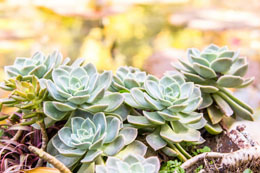Most succulent plants are native to the dry, hot desert regions, hence they thrive even with minimum attention. Basic care instructions revolve around providing adequate water and nutrients during active growth period. This article lists the different types of succulents and some instructions for maintaining healthy plants.

As the name goes, a succulent plant has a fleshy part that serves as a water reservoir. It stores water in certain parts, as a means to adapt in the least hospitable, dry habitats. When compared to flowering plants and other garden cultivars, succulent plants are easy to take care of. They are indigenous to dry arid regions and have a tendency to grow in poor nutrient soils. Even without regular watering and supplementation of nutrients, these desert plants still grow luxuriantly.
Identification
Common examples of succulent plants are aloe vera, agave, sansevieria, adenium (or desert rose), echeveria, crassula, and ponytail palm. Identification can be a bit difficult as most of the varieties develop similar looking leaves and stems. An easy way is to classify succulents with respect to the plant part where they store water. The major groups include:
Leaf Succulents: These types of plants store water in their fleshy leaves. Examples include aloe vera and ponytail palm. Cut open an aloe leaf and you will find that it is filled with a watery, gelatinous substance called sap. It is this aloe sap that possesses medicinal properties.
Stem Succulents: Nearly all cactus varieties fall into this group. Instead of foliage, they have scales and thorns to reduce water loss. The stems are hollow or spongy, which serve as a water reservoir. Several cactus species produce large flowers and are included in flower gardens.
Root Succulents: This group comprises plants (e.g.,
opuntia tuberosa and
brachystelma meyerianum) that use underground roots for storing water. This adaptive feature helps in reducing water loss by evaporation, and more importantly, desert animals which rely on plants for their water requirements are less attracted to these plants.
Care Instructions
The mode of propagation of these plants is cutting of the vegetative parts, stems, or roots. Hence, when you purchase them, you most probably bring home the stem or offshoot. As you cannot determine the size of mature plants with reference to the cuttings, ask a horticulturist about the plant size at maturity. That way, you can decide on the necessary pot dimensions and nutrient requirements.
The following are some basic care instructions that you need to follow:
Ideal Temperature
Based on the species, you can grow succulents as houseplants or as outdoor garden plants. These plants do not tolerate winter very well. Hence, if you are residing in very cold regions, consider protecting the plants from cold winter frost and wind. Plant them in a container and place them indoors during winter.
Light Exposure
One of the most important factors is ensuring maximum exposure to filtered light (not direct sunlight). When kept in direct sun, they may wither and dry out. If the plants facing the sun appear somewhat withered and yellowish, reduce light exposure.
Watering Frequency
Being native to dry climatic conditions doesn't mean that you should not water your plants. Water them deeply once in a week during the active period, i.e., spring and early summer. However, make sure that the top soil is dry before the next watering session. In the dormant period, you can water them less frequently (once in a month).
Supplement Fertilizers
Cactus and succulents thrive well in poor soil, but adding nutrients promotes healthy growth of the plants. Fertilizing can be done in spring, at the beginning of the active period. Use a flowering houseplant nutrient formula that contains low amounts of nitrogen. Also, only use a half or a quarter of the recommended dosage.
Problems
Keep an eye on the plant for mealy bugs and aphid infestations. If identified in the initial stage, spray the affected plants with a strong jet of water to get rid of the pests. Another tip is to dip a cotton ball in rubbing alcohol and wipe the affected parts. If required, you can apply a mild dose of insecticides.
Do not allow the plants to sit in stagnant water, as they cannot tolerate waterlogged soil and areas of low air circulation. Avoid excess watering to protect your houseplants from the cold, that way you can maintain luxuriant succulents in and around your home.






 As the name goes, a succulent plant has a fleshy part that serves as a water reservoir. It stores water in certain parts, as a means to adapt in the least hospitable, dry habitats. When compared to flowering plants and other garden cultivars, succulent plants are easy to take care of. They are indigenous to dry arid regions and have a tendency to grow in poor nutrient soils. Even without regular watering and supplementation of nutrients, these desert plants still grow luxuriantly.
As the name goes, a succulent plant has a fleshy part that serves as a water reservoir. It stores water in certain parts, as a means to adapt in the least hospitable, dry habitats. When compared to flowering plants and other garden cultivars, succulent plants are easy to take care of. They are indigenous to dry arid regions and have a tendency to grow in poor nutrient soils. Even without regular watering and supplementation of nutrients, these desert plants still grow luxuriantly.